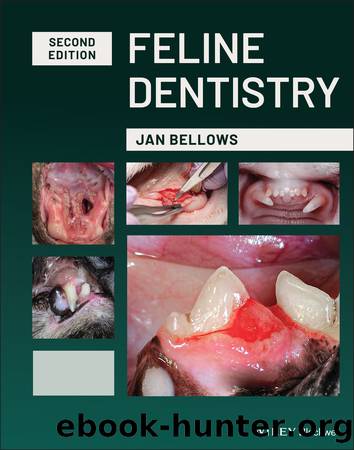Feline Dentistry by Bellows Jan;

Author:Bellows, Jan; [Bellows, Jan]
Language: eng
Format: epub
Publisher: John Wiley & Sons, Incorporated
Published: 2022-01-19T00:00:00+00:00
6
Tooth Resorption
Resorption is a common type of dental lesion that results in loss of tooth substance. Resorption can affect the cementum, dentin, pulp, and enamel. Tooth resorption is common in cats. Its recognition and treatment are important to patient health.
6.1 Prevalence
Tooth resorption affects 20â75% of mature cats depending on the population reported. One study found histologic evidence of resorption in all teeth of cats that had at least one tooth demonstrating resorption. This finding led to the hypothesis that given enough time all the teeth of affected cats will develop tooth resorption. Only 8% of the teeth examined from cats not demonstrating resorption had similar lesions.
Tooth resorption is rarely diagnosed in cats less than twoâyears of age. Most develop lesions by four to sixâyears of age. Purebred cats, such as the Abyssinian, Siamese, Russian blue, Scottish fold, and Persian breeds, appear to be overrepresented.
Tooth resorption has been reported to be more prevalent in cats that:
Gulp rather than chew their food
Eat only table food
Are older
Are female
Higher prevalence in oriental breeds
Drink municipal (as compared to well) water
Are on a raw liver diet or low calcium diet
Live exclusively indoors
Download
This site does not store any files on its server. We only index and link to content provided by other sites. Please contact the content providers to delete copyright contents if any and email us, we'll remove relevant links or contents immediately.
How to Be a Bawse: A Guide to Conquering Life by Lilly Singh(7162)
Spare by Prince Harry The Duke of Sussex(4794)
Millionaire: The Philanderer, Gambler, and Duelist Who Invented Modern Finance by Janet Gleeson(4108)
Machine Learning at Scale with H2O by Gregory Keys | David Whiting(3648)
Harry Potter 02 & The Chamber Of Secrets (Illustrated) by J.K. Rowling(3557)
Never by Ken Follett(3537)
The Heroin Diaries by Nikki Sixx(3325)
Urban Outlaw by Magnus Walker(3246)
Harry Potter and the Prisoner of Azkaban (Book 3) by J. K. Rowling(3116)
Japanese Design by Patricia J. Graham(3004)
Fairy Tale by Stephen King(2958)
The Man Who Died Twice by Richard Osman(2812)
The Club by A.L. Brooks(2750)
Stacked Decks by The Rotenberg Collection(2692)
Will by Will Smith(2584)
Harry Potter and the Deathly Hallows (7) by J.K. Rowling(2553)
Churchill by Paul Johnson(2370)
The Chimp Paradox by Peters Dr Steve(2232)
Borders by unknow(2119)
